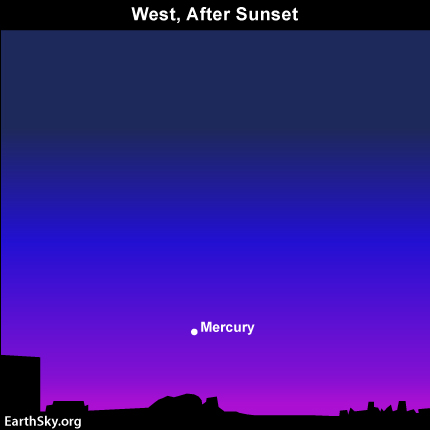Courtesy of EarthSky
A Clear Voice for Science
Visit EarthSky at
www.EarthSky.org

 Mercury, the solar system’s innermost planet, never strays far from the sun and into Earth’s nighttime sky. Today, however, this world reaches its greatest elongation east of the sun at 7 p.m. Mountain Daylight Time. Mercury swings to the end of its tether, at 19 degrees east of the sun. (For reference, your fist at an arm’s length approximates 10 degrees of sky.)
Mercury, the solar system’s innermost planet, never strays far from the sun and into Earth’s nighttime sky. Today, however, this world reaches its greatest elongation east of the sun at 7 p.m. Mountain Daylight Time. Mercury swings to the end of its tether, at 19 degrees east of the sun. (For reference, your fist at an arm’s length approximates 10 degrees of sky.)
Nineteen degrees east of the sun is not very far, but it is far enough to showcase Mercury as an evening “star” at dusk. For the northern hemisphere, this month stages Mercury’s best apparition in the evening sky for all of 2011. At mid-northern latitudes, Mercury sets about one and one-half hours after the sun right now.
Looking for a sky almanac? EarthSky recommends
At middle latitudes in the southern hemisphere, Mercury sets only about one-half hour after the sun. So why does Mercury stay out so much longer after sunset in the northern hemisphere? It is because the ecliptic – the pathway of the planets – hits the horizon at a steep angle on early spring evenings. However, in the southern hemisphere –where it is early autumn – the ecliptic intersects the horizon at a narrow angle at evening time.
As seen from the northern hemisphere, Mercury stands above the setting sun. From the southern hemisphere, Mercury sits to the side of the setting sun. That is why Mercury sets so much later after sunset in the northern hemisphere than in the southern hemisphere during March of 2011.
In the northern hemisphere, Mercury should remain in good view until the end of the month. Look for Mercury to shine low in the west some 45 to 75 minutes after sunset.
Astronomy Picture of the Day from NASA/JPL
U.S. Naval Observator Astronomical Information center
The York County Astronomical Society
 Print This Post
Print This Post








